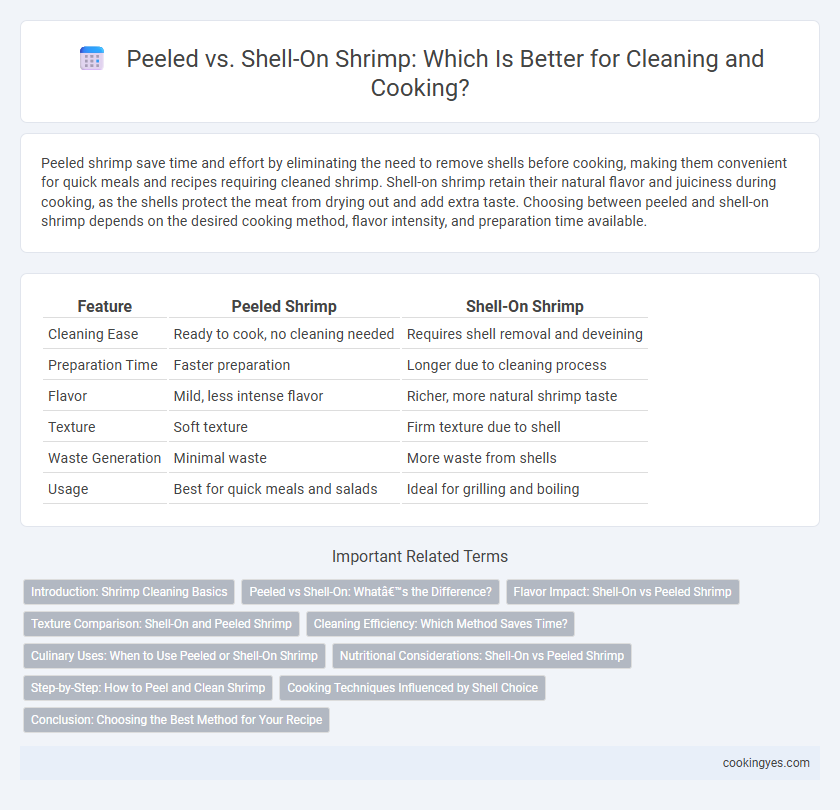Peeled shrimp save time and effort by eliminating the need to remove shells before cooking, making them convenient for quick meals and recipes requiring cleaned shrimp. Shell-on shrimp retain their natural flavor and juiciness during cooking, as the shells protect the meat from drying out and add extra taste. Choosing between peeled and shell-on shrimp depends on the desired cooking method, flavor intensity, and preparation time available.
Table of Comparison
| Feature | Peeled Shrimp | Shell-On Shrimp |
|---|---|---|
| Cleaning Ease | Ready to cook, no cleaning needed | Requires shell removal and deveining |
| Preparation Time | Faster preparation | Longer due to cleaning process |
| Flavor | Mild, less intense flavor | Richer, more natural shrimp taste |
| Texture | Soft texture | Firm texture due to shell |
| Waste Generation | Minimal waste | More waste from shells |
| Usage | Best for quick meals and salads | Ideal for grilling and boiling |
Introduction: Shrimp Cleaning Basics
Peeled shrimp save time and effort during meal preparation by eliminating the need to remove shells, making them ideal for quick cooking methods like sauteing or grilling. Shell-on shrimp retain more flavor and moisture when cooked, as the shells protect the meat and help lock in juices, enhancing taste and texture in dishes like boiled or steamed shrimp. Proper cleaning involves rinsing under cold water, deveining by removing the digestive tract, and choosing peeled or shell-on shrimp based on recipe requirements and cooking preferences.
Peeled vs Shell-On: What’s the Difference?
Peeled shrimp have their shells completely removed, offering convenience and quicker preparation for dishes, while shell-on shrimp retain their protective exoskeleton, enhancing flavor and moisture during cooking. Cleaning peeled shrimp involves deveining and removing any residual membrane, whereas shell-on shrimp require additional effort to peel and clean before consumption. Choosing between peeled and shell-on shrimp depends on the desired cooking method, flavor intensity, and ease of preparation.
Flavor Impact: Shell-On vs Peeled Shrimp
Shell-on shrimp retain more natural juices and oils during cooking, intensifying their flavor and offering a sweeter, more succulent taste compared to peeled shrimp. Peeled shrimp, while convenient, often lose some of this richness as the protective shell holds in essential flavors and aromas. The shell also provides a slight texture contrast and imparts subtle briny notes that enhance overall dish complexity.
Texture Comparison: Shell-On and Peeled Shrimp
Shell-on shrimp maintain a firmer, more resilient texture due to the protective exoskeleton, which helps lock in moisture during cooking. Peeled shrimp tend to have a softer, more delicate texture because the removal of the shell exposes the tender flesh directly to heat. This difference influences the mouthfeel and overall eating experience, with shell-on shrimp often preferred for grilling and peeling ideal for quick sauteing or incorporation into dishes.
Cleaning Efficiency: Which Method Saves Time?
Peeled shrimp significantly improve cleaning efficiency by eliminating the need to remove shells during cooking, reducing prep time by up to 50%. Shell-on shrimp require additional steps for shell removal and deveining, increasing overall cleaning time. Choosing peeled shrimp streamlines meal preparation, especially for quick recipes and large batches.
Culinary Uses: When to Use Peeled or Shell-On Shrimp
Peeled shrimp are ideal for quick-cooking dishes such as stir-fries, salads, and pastas where convenience and texture are important, allowing flavors to penetrate evenly. Shell-on shrimp enhance flavor and moisture retention in grilling, roasting, or boiling, providing a richer taste and protecting the delicate flesh during cooking. Choosing between peeled and shell-on shrimp depends on the cooking method and desired flavor intensity, with shell-on preferred for slow or high-heat preparations and peeled favored for fast, easy-to-eat recipes.
Nutritional Considerations: Shell-On vs Peeled Shrimp
Shell-on shrimp retain more nutrients such as calcium and antioxidants found in the exoskeleton, which are often lost during peeling. Peeled shrimp offer convenience and faster cooking but may have slightly reduced mineral content compared to shell-on varieties. Consuming shell-on shrimp can maximize nutritional benefits while requiring additional preparation time.
Step-by-Step: How to Peel and Clean Shrimp
Peeling and cleaning shrimp begins by removing the shell, starting from the legs and working toward the tail to peel it off easily. Next, devein the shrimp by making a shallow cut along the back and extracting the black vein with a knife or toothpick. Rinse the peeled shrimp under cold water to remove any residual shells or debris, ensuring they are ready for cooking.
Cooking Techniques Influenced by Shell Choice
Choosing peeled shrimp streamlines cooking processes such as sauteing and stir-frying, offering quicker heat penetration and uniform seasoning absorption. Shell-on shrimp deliver enhanced flavor and moisture retention during grilling and roasting, as the shell acts as a natural barrier against direct heat. Steaming and boiling benefits from either preparation, though shelled shrimp require less cooking time due to direct heat exposure on the flesh.
Conclusion: Choosing the Best Method for Your Recipe
Choosing between peeled and shell-on shrimp depends on cooking method and flavor desired. Peeled shrimp offer convenience and faster cooking, ideal for stir-fries and salads, while shell-on shrimp retain moisture and enhance taste during grilling or boiling. Assess recipe requirements and personal preference to select the best option for optimal texture and flavor.
Peeled vs shell-on for shrimp cleaning Infographic

 cookingyes.com
cookingyes.com